Sometimes critters leave behind mementos of their visit that remain long after they’re gone. Chipmunk holes are one notable example, and while the entrance to a burrow can be tiny, chipmunk tunnels are around three feet deep and can stretch a good 20 to 30 feet underground.
Filling in the hole with dirt might seem like an obvious solution, but chipmunks (or other critters) may still reclaim the burrow and reopen the hole. Here’s how to fill a chipmunk hole and ensure it won’t be excavated again.
What Does a Chipmunk Hole Look Like?
The entrances to a chipmunk burrow are only two to three inches in diameter, making them hard to spot. You’ll usually find them near food sources such as bird feeders or pet food containers. For added protection, these chipmunk burrows tend to be concealed by potted plants, shrubs and flower beds, or other good ground cover.
Chipmunks transport dirt in their cheeks, so the entrance will look clean and level with the ground.
Filling in a Chipmunk Hole
There are a few ways to fill a chipmunk hole. While dirt may seem the obvious choice, this won’t stop chipmunks from simply digging holes in the same spot later. Instead, we recommend the following methods which we’ve personally found give excellent results.
Method 1 – Cat Litter
For those who have feline family members, used litter can be used to both fill and repel. Filling a chipmunk hole with used litter makes it much harder for them to excavate the old tunnel entrance.
Not only is the litter crumbly and more likely to cave in, but it will taste terrible. Furthermore, the urine smell will permeate the den, leading them to believe a predator has invaded.
If you use clay litter, try switching to clumping pine. Not only does it greatly reduce the litter box smell, but it's a low dust, renewable resource. This means it's healthier for the environment, easier on asthma or dust allergies, and is fully biodegradable.
Cat litter has a few drawbacks, however. The most obvious one is that that you need a cat to provide potent filler material. You can get past this by getting the litter from a neighbor.
More importantly, ammonia is very strongly alkaline with a pH of 11.1. The average garden plant requires a soil pH somewhere between 6.0 and 7.4. Over time, the litter’s ammonia will contaminate the soil around it, resulting in a toxic environment for most plants.
Method 2 – Fine Gravel
A more flora-friendly method is to use fine gravel or very course sand. The particles are unstable, causing the hole to refill as fast as a chipmunk can excavate it. Even better, these materials (known as aggregates) improve drainage, reduce soil compacting, and allow plant roots to spread out more efficiently.
Additionally, the gravel can be topped with a bit of topsoil or turf to make the filled hole blend in with its surroundings. You can even add one part soil per three parts gravel to ensure your deeper-rooting plants have more food.
Method 3 – Sand/Cement
A third method can be a little more extreme, but works best near your foundation or other sensitive parts of the property. Begin by filling all but the last four to five inches with dry sand.
A finer-grained sandbox sand is a good choice for this method. It will have a similar overall effect as filling the hole with gravel or a coarser sand but is more compact.
Next, cap the hole with cement. As the cap is narrow, the sand will still allow for proper drainage. Leave the last one to two inches for topsoil so any ground cover can obscure the former den.
Read Also: Do Poison Peanuts Work on Chipmunks?
Method 4 – Chipmunk Traps
This method honestly isn’t bad on paper, but can be terrible in execution. It’s best used when you aren’t sure if the chipmunk burrow is occupied to avoid burring any chipmunks alive.
The key is in the types of chipmunk traps you invest in. Always aim for humane traps as opposed to a kill trap. You will want to place the traps at any entrances you can identify.
Either cover all the holes with camouflaged live traps containing the chipmunk’s favorite foods, or keep one entrance open as your attack vector.
The goal here is simple. Keep an eye on the traps and remove any that have become occupied. As with all members of the rodent family, release the captives at least five miles from your home. After about a week, any chipmunks should have left and you can fill the hole.
Be warned, if you catch multiple adults, there may be baby chipmunks still trapped below ground. Call an animal control specialist to check and remove any babies before filling the hole.
As for the attack option, use your garden hose to flood the burrow and (hopefully) send the chipmunks scurrying into the awaiting cages at ground level. This tactic isn’t the most effective solution and can drown any babies as well as create other side effects. Use this method with extreme caution.
Method 5 – The Darwin Methods
Rather than being a single method, let’s look at a combination of seemingly permanent solutions that often do better at earning a Darwin award than actually resolving the burrow issue.
Poisonous Chemicals
Poison pellets dropped into a used or abandoned hole is just looking for trouble. In fact, dumping chemicals into chipmunk holes is a bad idea on multiple levels. For example, chipmunks are generally solitary until mating season.
Those poisons may hit one rodent, or the burrow could end up filled with dead chipmunk bodies. The stench will permeate the immediate ground and attract all sorts of unwanted bugs. While it won’t be as bad as the infamous Holy Innocents’ Cemetery of Paris, it will still cause a lot of problems for your family and plants.
Additionally, chipmunk poisons can also affect other critters, including pets or beneficial animals. Simply poisoning a hole won’t stop other critters from trying to move in, only to meet an untimely demise underground.
Disguising the Hole
The other Darwinian method we’ll mention is trying to make the holes look like they belong to a predator. Mounds of dirt surrounding the holes might look convincing to a human, but chipmunks have noses that work quite well. Even worse, this process doesn’t remove the holes and can even attract other pests who will confiscate the burrow.
All in all, there’s a reason why you don’t hear this tactic very often. If you want the chipmunk to believe there’s a predator present, either fill the holes with cat litter or use decoy deterrents. Don’t simply rely on a few piles of dirt to scare an intelligent critter.
Preventing Future Chipmunk Holes
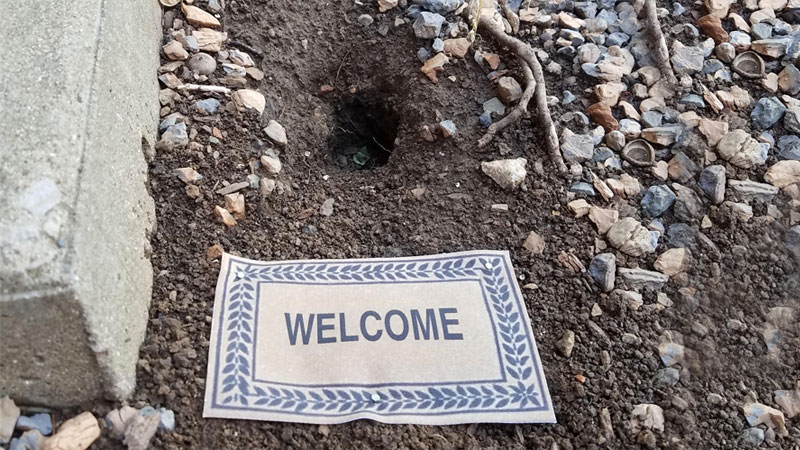
As with most burrowing critters such as prairie dogs, moles, groundhogs, and voles, chipmunks create a home with long tunnels (up to 30 feet long) and multiple entrances. This means filling the holes in your yard might not be enough to keep them from creating new entrances from underground.
Not only do the holes cause extensive yard damage over time, but the tunnels themselves can put your entire home at risk if the chipmunk infestation creates too many voids under the foundation. A good defense is critical for getting rid of chipmunks for good.
Fencing
A fence extending underground will help ensure chipmunks (and most other four-legged critters) stay out once evicted.
The best fencing choice will either be a privacy fence or good mesh fence (such as the ever-popular chicken wire). Be warned that any fence material with holes measuring 2-3 inches wide (such as with chain link) will still allow chipmunks through.
The fence itself should extend at least eight inches below ground. This is deep enough to discourage chipmunks. Even better, their poor climbing ability (despite what Disney tells you – remember, Chip and Dale are giant anthropomorphic critters and thus can do many things the average chipmunk cannot) means they won’t be able to easily scale a mesh fence.
A good, easy to install alternative is the Dig Defence which not only keeps critters out, but your pets in.
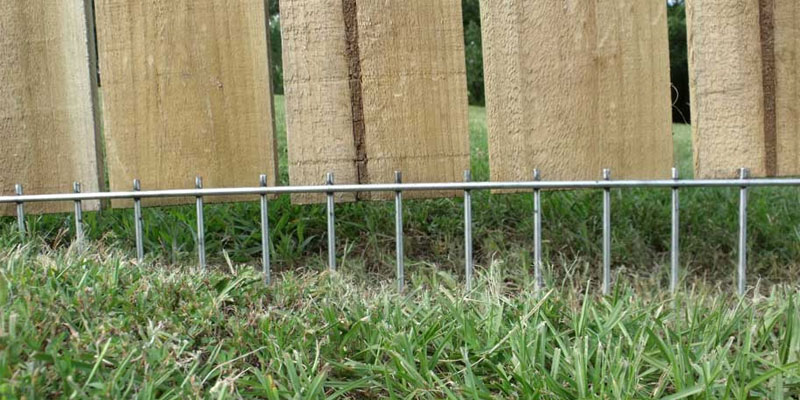
You can combine a wooden privacy fence with mesh for a more attractive look. Simply bury the mesh portion and connect it to the inside bottom of the privacy fence approximately two inches up from the base. You can then cover and further secure this exposed portion of mesh using a baseboard.
Deterrents
There are a lot of great products out there, from electronic repellents to predator urine crystals (said to work against the toughest xenomorphs), and motion-activated sprayers or noisemakers.
Whether you’ve filled previous holes with gravel, litter, or capped them, a chipmunk can always just start over. Therefore, it’s a good idea to keep them away from areas you know they’ve burrowed previously using one of these deterrent methods.
See Also: Best Squirrel Traps and Repellents
- How to Get Rid of Hawks - March 8, 2024
- How to Get Rid of Pill Bugs (Rolly Pollies) - March 1, 2024
- How to Get Rid of Groundhogs (Woodchucks) - February 5, 2024

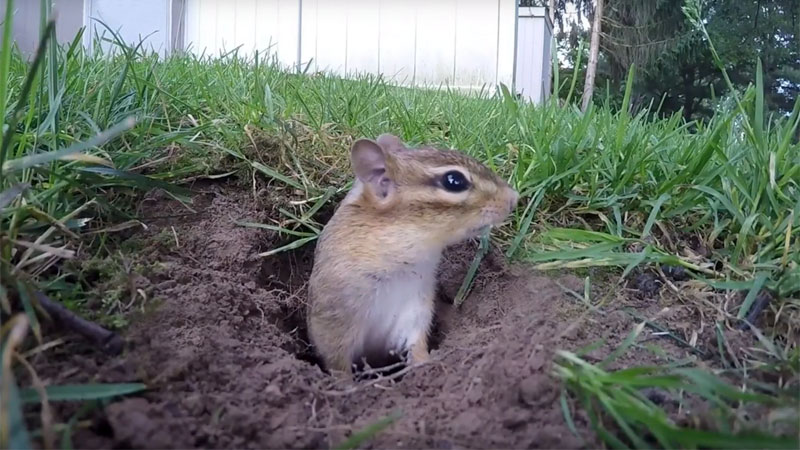

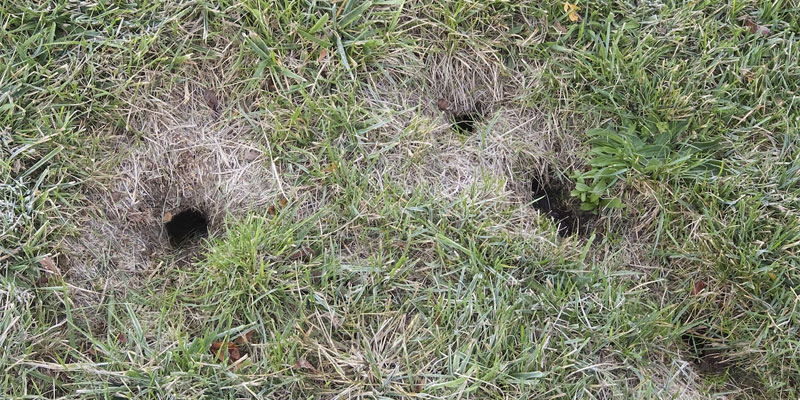
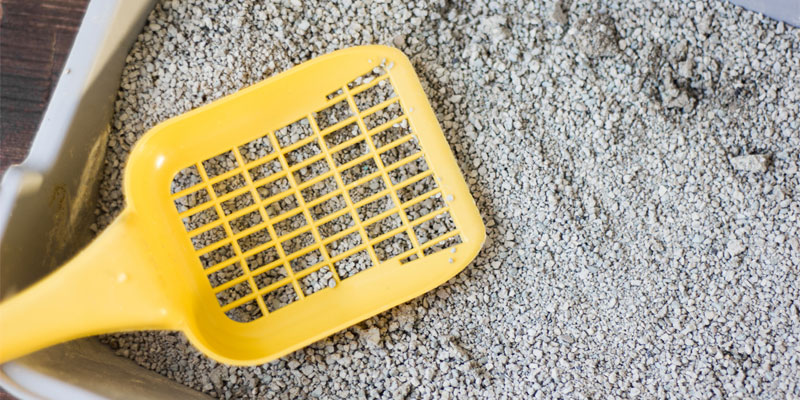
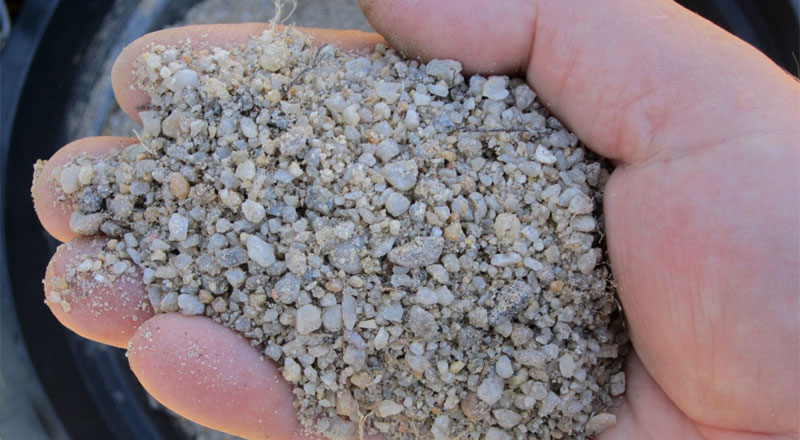
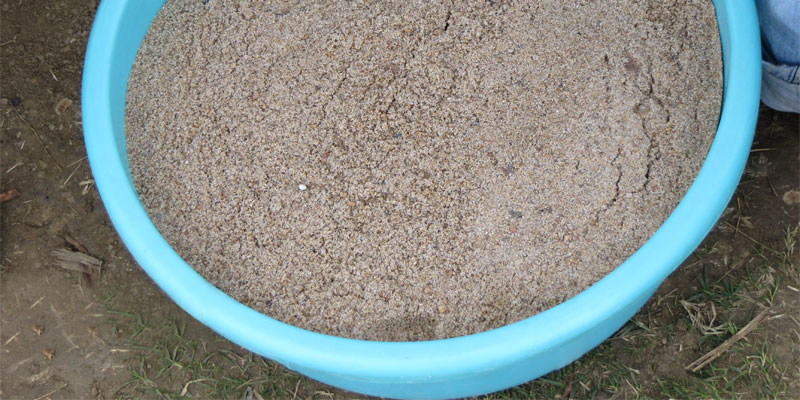
Thanks, I have been unsuccessful so far. I’ll try your methods and change my luck.
Using old kitty litter works. Done it
I was wondering, as a twist on option one (seeing as I do not have a cat), would the addition of dog poop into the hole along with just soil or sand and soil be a similar deterrent? I know I have chipmunks (and a lot of tunnels around my foundation). But, I’m pretty sure I also have groundhog(s) or possibly moles. Farther away from the house (in the far backyard that connects to a farm field) there are raised tunnels in the yard which is different than what’s around the house. And this morning, my little dog fell into a hole with a diameter about 4 inches wide in the front yard right next to the street. It didn’t seem like a chipmunk’s doing. So, that one in particular I’d like to fill. Thanks for any suggestions.
Unfortunately, dog poop may actually attract other pests such as mice and rats. With cat litter, it’s the combination of the granules and pee smell/taste that would deter chipmunks.
The tunnels could chipmunks, moles, or gophers. Usually, one type will be more common in an area. Might be worth checking with neighbors.
Super helpful. Glad I checked before doing anything. And thanks for such a quick response
I don’t have a cat and won’t buy one so I have this question. Would human urine deter chipmunks like the cat urine?
It needs to be some sort of natural predator to chipmunks. Fox urine is fairly cheap and can be found at Cabelas, Tractor Supply, and other stores. Or you can just buy it on Amazon.
Do I really need to make sure there are no chipmunks in the hole before I fill it??
They have such an intricate tunnel system and always have an exit ready.
I have many chipmunk holes in my yard. I wouldn’t dare do something to harm the environment or to take a chance in killing any of our small little critters. They may have babies in that nest. I would suggest just leave Wildlife alone. There is no sure way to know if the animals are still living in that nest and entering through a different entrance way. Cruelty is never the answer. I can’t believe some of the things people think up to hurt wildlife.
Nothing in this post says anything about hurting wildlife . We leave wildlife alone as long as they aren’t damaging our property. Some years ago, we had chipmunks burrowing under our foundation, and we have the foundation cracks and buckled siding to prove it. We could actually hear them under the floor of the livingroom/diningroom area. So, they had to go. We trapped them alive and relocated them far enough away that they wouldn’t come back. Our newest chippys don’t dig under the foundation, so we leave them alone.
We bought a small “Have A Heart” and removed a dozen this summer, have only seen 1
in my yard this week. Filled the holes. I don’t know if I’ll do my birdfeeders this fall, though.
I take a garden plant shovel n stick it partially in the hole, sprinkle Cheyenne pepper squirrel powder on top of the shovel, n take my leaf blower n blow a few tablespoons of the pepper into the hole.
Nice